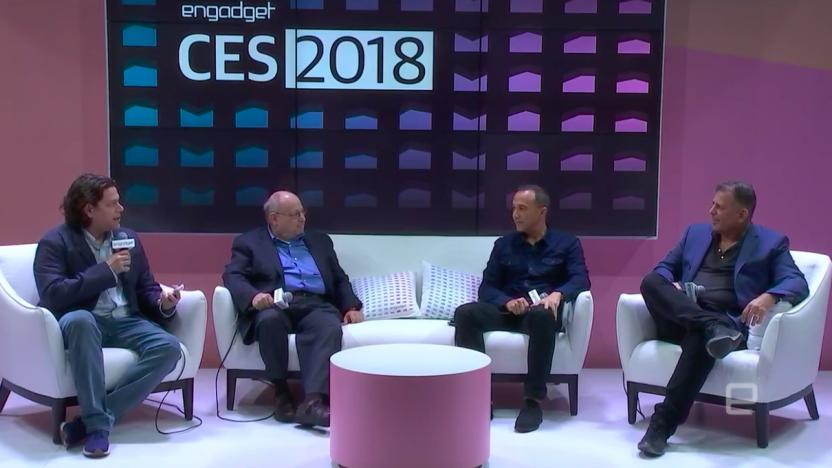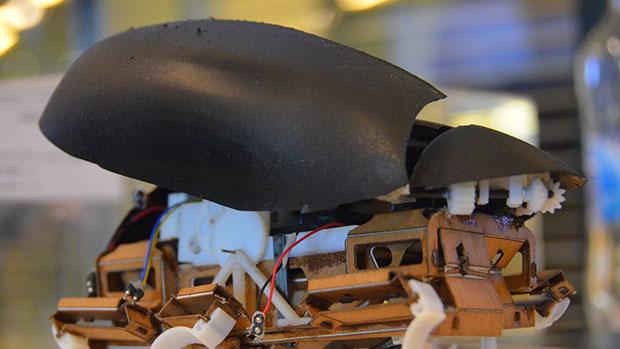ieee
Latest

Major science publisher bars Huawei from reviewing papers
The US' effective ban on Huawei might have serious consequences for the scientific community. One of the largest science publishers, IEEE, has banned Huawei scientists from reviewing papers so long as the trade restrictions are in place. There are "severe legal implications" from allowing the Chinese company's staff to look at technical research, IEEE told editors of its roughly 200 journals. Huawei can still serve on IEEE editorial boards.

How humans will learn to love the robots of tomorrow
For the Perfect Strangedroids discussion panel on Wednesday, Engadget hosted a trio of robotics experts. Sabri Sansoy, CEO and chief roboticist of Orchanic; Nader Hamda, founder and CEO of Ozobot; and Stu Lipoff, IEEE Life Fellow and president of IP Action Partners all took the Engadget stage at CES 2018, with senior editor Andrew Tarantola moderating. Click here to catch up on the latest news from CES 2018.

Latest robot roach can leap like the real thing
Look away entomophobes: a collaboration between South Korea's Seoul National University and UC Berkeley has created an unholy robotic cockroach that can not only crawl around to gross you out, but can also jump a solid five feet in the air and then prop itself up and keep on walking.

German scientists are training robots to 'feel' pain
Pain is important. It triggers the appropriate response to prevent even greater injuries or even to save your life. A couple of German researchers think so too, so they're working on a way to make robots "feel" -- or, more accurately, to detect and respond to -- pain. That way, they can move away from anything that could damage them, thereby lengthening their lifespans and preventing the need for costly repairs.

Japanese researchers invent a throwable 'Droideka' drone
A team of researchers from Japan's Chiba Institute of Technology recently presented a novel robot design at the IEEE/RSJ International Conference on Intelligent Robots and Systems. It can be thrown like the Explorer camera sphere, but after it stops rolling, this nimble quadruped unfurls mechanical legs to skitter the rest of the way to its destination -- basically the same idea as Star Wars' Droideka, just without the laser cannons (yet).

Yes, these tiny robots can (autonomously) move a car
A swarm of small robots developed by a team of European scientists can carefully extract and transport vehicles up to two tons in weight. These tiny machines and their larger deployment unit are collectively called Avert, short for "Autonomous Multi-Robot System for Vehicle Extraction and Transportation." As the name implies, the system needs very little human input: it can scan the area and look for potential obstacles to plan its safest route. The deployment unit will then release the small robots, which attach themselves to the vehicle that needs extraction. As much as we'd love for Avert to rescue us from bad parking situations, though, it was specifically developed for use by law enforcement.

MIT's robotic limbs pave the way for real-life Doc Ock (video)
Two groups of MIT scientists are working on robotic limbs, which when worn together can make you look like one famous comic book villain: Doctor Octopus. Unlike prosthetic limbs developed to replace real ones, the teams' (from MIT's d'Arbeloff Laboratory) Supernumerary Robotic Limbs (SRLs) are designed to supplement your existing arms. One team showcased its latest shoulder-mounted SRL prototype at the IEEE International Conference on Robotics and Automation in Hong Kong, where members showed how it can take over tasks when your real arms are too busy. These particular SRLs take data collected by the accelerometer and gyro embedded in the base of the shoulder mount, as well as their accompanying wrist monitors. The limbs then move on their own based on your actions -- for instance, they move up when you raise your real arms, and in the future, they could open doors when you're carrying something.

nVoy program will certify hybrid networking, aim for digital harmony
There's practically an overabundance of certifications for individual networking standards, but we haven't seen many attempts at an uber-certification that ties it all together. Enter nVoy: the upcoming program will greenlight Ethernet, HomePlug, MoCA and WiFi devices that obey the IEEE 1905.1 standard for hybrid networks. Any gadget that gets the new seal of approval should be easier to set up and troubleshoot when it's talking to other nVoy-ready products, whatever networking method they use. The first certified hardware won't surface until the end of the year, but we'll bide our time if it simplifies wiring up a basement home theater.

'First' prototype hardware built for broadband over IEEE's white space standard
If you hadn't realized already, spectrum is quite the hot commodity, and any unused slice is a potential data highway just begging to be cruised. One mostly vacant stretch is the eerie white space -- megahertz left empty when TV broadcasts move from analog to digital frequencies. The IEEE published its 802.22 standard for white space broadband 18 months ago, and now a group comprising the NICT, ISB Corp and Hitachi Kokusai Electric (not to be confused with the other Hitachi) have built the "first" prototype hardware to make use of it. White space spectrum in the 470 to 710MHz range is expected to provide wireless internet to "underserved areas" and act as an emergency backup for downed systems, when infrastructure is finally up and running. Given we're only at the prototype stage following the inception of the 802.22 standard in 2011, out-of-towners will probably be waiting a while longer before having the option to stream entertainment over those dead TV airwaves. Fate, it seems, is not without a sense of irony.

Ethernet gets new IEEE standard, still requires your thumbnail
If you've been taking your trusty ethernet cable for granted since 1985, then we don't blame you -- that's when the IEEE 802.3 standard was first published and it hasn't had a full revision since 2008. Behind the scenes, however, the IEEE Ethernet Working Group has continued to add extras like 100Gbps compatibility (1Tbps will have to wait), improved energy efficiency and greater suitability for in-car networking. As of today, all of those amendments have been incorporated into 802.3-2012, which makes this a good time to pay homage and remember just how often thin air lets you down. [Tattoo credit: Nick Thompson, Sinoth.net]

IEEE pushes for Ethernet standard between 400Gbps and 1Tbps, hopes to head off big data crunch
Ethernet might seem passé to those of us toting Ultrabooks, but it's important enough to provoke a crisis for internet providers and many of those who depend on high-speed computing networks for a living: based on the rises of streaming video and social networking, the IEEE is worried that many of those large-scale networks will need 10Tbps of total bandwidth just to avoid a logjam in 2020. To that end, the standards body has formed a Higher-Speed Ethernet Consensus group that's mulling a new, breakneck-speed format reaching either 400Gbps or 1Tbps, depending on whose approach you'd favor. Fight the urge to pick the 1Tbps option on instinct, however. Both options would depend on bonding multiple connections together, and the faster of the two formats could lead to some expensive and very ungainly cables if it's not handled well. A meeting is scheduled for late September in Geneva to at least begin hashing out the details. Although we won't be wiring our homes with terabit Ethernet anytime soon, the standard should come quickly enough that the Googles and Netflixes of the world can satisfy our data addictions for a good while longer. [Image credit: Justin Marty, Flickr]

Visualized: a look inside iRobot's gadget-filled 'cool stuff room' (video)
We've all seen a Roomba at one point or another, be it picking up debris around our feet in a friend's living room or chauffeuring a courageous kitty for an entertaining clip on YouTube. Likely far less familiar, however, is iRobot's gadget-filled Massachusetts headquarters, including the museum-like "cool stuff room" in the lobby. There you'll find a large variety of autonomous devices, ranging from an early Roomba prototype that subs in a removable cloth for the vacuum to the relatively creepy My Real Baby -- an $89 doll that cries for food and offers realistic reactions to tickling. There's also plenty of industrial and military gear on hand, including a long cylindrical bot used for repairing oil rigs as they continue to operate, a full-size self-driving vehicle and a wall-climbing robot that uses suction cup wheels to ascend vertically. Some of the exhibits are downright creepy, such as a crab-like prototype which an iRobot employee referenced as being "inspired by nature," though the company's familiar household gadgets help to balance out the eerie. Sadly, the collection doesn't appear to be open to the public, though IEEE was granted a tour, which it graciously filmed for your enjoyment -- you'll find that video walkthrough just past the break.

Arthur P. Stern, instrumental in inventing the color television and GPS, passes away
Engadget learned that Arthur P. Stern passed away on May 24th, 2012, but just this week, The Los Angeles Times has published a laudable look back at a man that had an enormous impact on the technology that we rely on -- and, quite frankly, take for granted -- each and every day. Born in 1925 in Budapest, Hungary, Arthur went on to obtain an M.E.E. from Syracuse University, joining General Electric in 1951 and making a near-immediate impact in the realm of television. He's widely credited with pioneering the color TV that we're familiar with today (and holding a related patent -- number 2920132 -- granted in December of 1953), while also publishing initial technical papers on transistor radios. As if that weren't enough, he was also instrumental in the progress of GPS, spearheading the development of key elements in the latter portion of his career. As fantastic as Stern was as an inventor, he was also a beloved grandfather to Joanna Stern, one of the industry's premiere technology reporters. Currently, Joanna works at ABC News, though she has spent time at LAPTOP Magazine, The Verge and right here at Engadget prior. From the entire staff, our deepest sympathies go out to a wonderful colleague and peer. The world has lost a brilliant mind, but on a personal level, a friend has lost much more.

Exploit uses firewalls to hijack smartphones, turns friends into foes
Normally, firewalls at cellular carriers are your best friends, screening out malware before it ever touches your phone. University of Michigan computer science researchers have found that those first lines of defense could be your enemy through a new exploit. As long as a small piece of malware sits on a device, that handset can infer TCP data packet sequence numbers coming from the firewall and hijack a phone's internet traffic with phishing sites, fake messages or other rogue code. The trick works on at least 48 carriers that use firewalls from Check Point, Cisco, Juniper and other networking heavy hitters -- AT&T being one of those providers. Carriers can turn the sequences off, although there are consequences to that as well. The only surefire solution is to either run antivirus apps if you're on a mobile OS like Android or else to run a platform that doesn't allow running unsigned apps at all, like iOS or Windows Phone. Whether or not the exploit is a serious threat is still far from certain, but we'll get a better sense of the risk on May 22nd, when Z. Morley Mao and Zhiyun Qian step up to the podium at an IEEE security symposium and deliver their findings.

New 802.1aq standard promises to improve Ethernet efficiency
Yesterday the IEEE announced an update to the 802.11 WiFi standard, and today it's promptly moving on to the Ethernet side of things. The association just approved the 802.1aq Shortest Path Bridging standard, which will streamline the management and build-out of networks by using the latest-gen VLAN with a higher service capacity. Basically, a larger scale for more efficiency and less errors. Head past the break for the full presser.

802.11-2012 WiFi freshens up spec with 3.7GHz bands, mesh networking
It's hard to believe that 802.11 WiFi has only had three major revisions since it was started up 15 years ago. The IEEE must be equally surprised, as it's introducing a new 802.11-2012 standard that unites 10 technologies from various amended WiFi versions under one big tent. Among the picks are new support for 3.65 and 3.7GHz bands, to avoid clashing with 2.4GHz or 5GHz networks, as well as better support for direct linking, faster cellular hand-offs, in-car networks, roaming and mesh networking. You can pay $5 to have a peek at the 2012 WiFi spec today, although we'd brace for a significant wait before smartphones and routers ship with the new 802.11 format -- we know how long it can take for a WiFi standard to become a practical reality.

Fukushima technician gives behind-the-scenes look at the cleanup operation
New details about the robotics deployed to help clean up Japan's Fukushima nuclear plant have emerged, thanks to a series of blog posts penned by an anonymous technician. Known only as 'S.H.', the blogger wrote of the effectiveness of the donated iRobot Packbots and Warriors (despite their prolonged exposure to electronics-damaging radiation), while criticizing the Tokyo Electric Power Company for what he saw as inept supervision, unreasonable schedules and disregard for technician safety. S.H., who helped retrofit a vacuum cleaner onto a robot to collect radioactive dust, also revealed technical details about the robots, explaining that they were manipulated with a PlayStation-style controller via a Panasonic Toughbook and that the devices were most effective in pairs, which allowed for better wireless connectivity and faster emergency response. The site was taken down after it began circulating on Twitter but IEEE kept and translated the posts, available for your perusal at the source link, below.

IEEE brings white space internet one step closer, we almost felt a twinge
Kudos to the IEEE for rushing this new 'super WiFi' standard through so very speedily for the sake of rural communities with poor web access. Designated "IEEE 802.22," it promises to bring speeds of up to 22Mbps to devices as far as 60 miles away from the nearest transmitter. How's that possible? Well, the standard carefully exploits swathes of unused white space within transmission bands that were originally reserved (and jealously guarded) for analogue TV. These frequencies currently contain nothing but hiss and occasional communications from dead people, but one day they could and should be filled with the hopes, aspirations and Facebook updates of country folk who are very much alive. Read the signs in the PR after the break.

HomePlug and IEEE want our home networks to play nice, talk to each other
HomePlug hasn't exactly struck it big on the home networking scene but, with so many disparate options (none of which play very nice together) it's not hard to see why. The Powerline Alliance is throwing its support behind a new IEEE standard, P1905, that may ease our consumer pain and make the outlet connectivity tech a better fit for our dungeons living rooms. The goal is to create a layer that sits atop the various wired and wireless hookups that blanket our homes and let them easily share data. Bridging the gap between HomePlug, HomePlug AV, Ethernet, WiFi, and MoCA is an ambitious task to tackle, but we've got faith our gadgets can get along.

IEEE approves next generation WiMAX standard, invites you to meet 802.16m
It's a term (and a technology) that has been bandied about for around four years now, but after waiting far too long for the next next best thing, the Institute of Electrical and Electronics Engineers has just given its oh-so-coveted stamp of approval to 802.16m. For those unfamiliar with such a term, that's the standard for next generation WiMAX, which may end up being capable of handling downstream rates of over 300Mbps. 'Course, those that were around during CEATEC last year know that Samsung already hit that in testing, but we're starting to feel as if that 1Gbps theoretical maximum that we were teased with in 2007 (and again last year) won't ever breach reality. It's tough to say what this approval means on the consumer front -- over the past four years, a tremendous amount of carriers have switched their allegiance to LTE, and even if WiMAX 2.0 finds itself ready for public consumption in the near future, it'll take a serious operator commitment before you'll ever enjoy the spoils. So Sprint, you feeling froggy?









